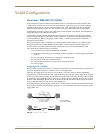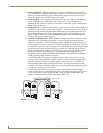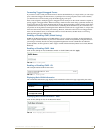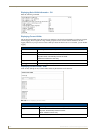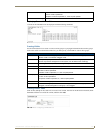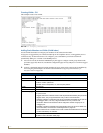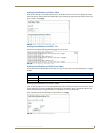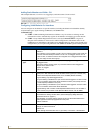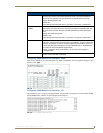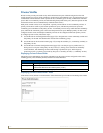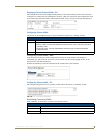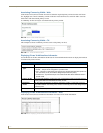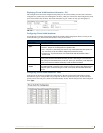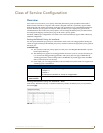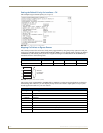
VLAN Configuration
131
NXA-ENET24 - Software Management Guide
Configuring VLAN Behavior for Interfaces - Web
Click VLAN, 802.1Q VLAN, Port Configuration or Trunk Configuration. Fill in the required settings for each
interface, click Apply.
Configuring VLAN Behavior for Interfaces - CLI
This example sets port 1 to accept only tagged frames, assigns PVID 3 as the native VLAN ID, enables GVRP,
sets the GARP timers, and then sets the switchport mode to hybrid.
Command Attributes (Cont.)
• GARP Leave Timer: The interval a port waits before leaving a VLAN group. This time should be set to more
than twice the join time. This ensures that after a Leave or LeaveAll message has
been issued, the applicants can rejoin before the port actually leaves the group.
• Range: 60-3000 centiseconds
• Default: 60
• Timer settings must follow this rule: 2 x (join timer) < leave timer < leaveAll timer
• GARP LeaveAll
Timer:
The interval between sending out a LeaveAll query message for VLAN group partici-
pants and the port leaving the group. This interval should be considerably larger than
the Leave Time to minimize the amount of traffic generated by nodes rejoining the
group.
• Range: 500-18000 centiseconds
• Default: 1000
• Timer settings must follow this rule: 2 x (join timer) < leave timer < leaveAll timer
•Mode: Indicates VLAN membership mode for an interface. (Default: 1Q Trunk)
• 1Q Trunk – Specifies a port as an end-point for a VLAN trunk. A trunk is a direct link
between two switches, so the port transmits tagged frames that identify the source
VLAN. Note that frames belonging to the port’s default VLAN (i.e., associated with
the PVID) are also transmitted as tagged frames.
• Hybrid – Specifies a hybrid VLAN interface. The port may transmit tagged or
untagged frames.
•Trunk Member: Indicates if a port is a member of a trunk. To add a trunk to the selected VLAN, use the
last table on the VLAN Static Table page.
FIG. 141
Web - Configuring VLANs per Port
FIG. 142 CLI - Configuring VLANs per Port



